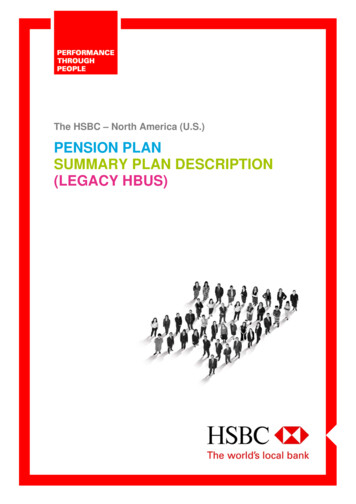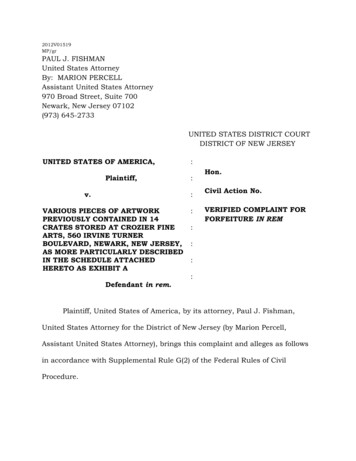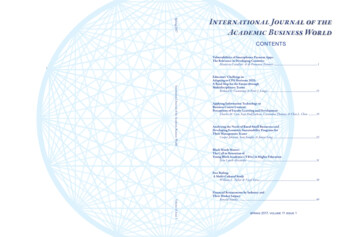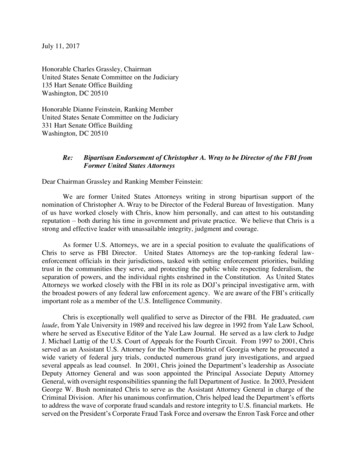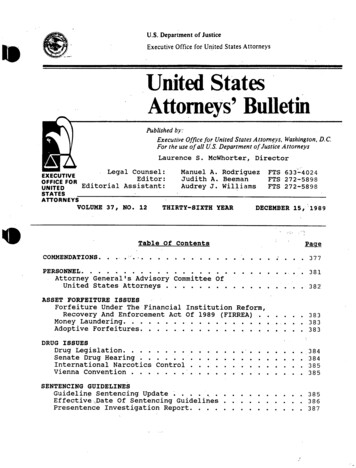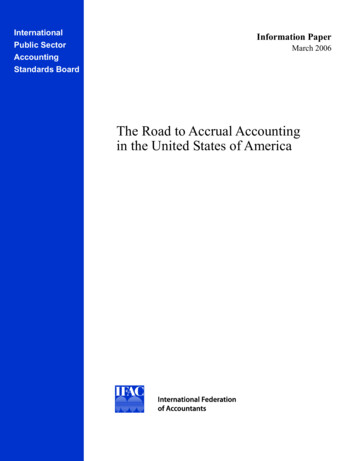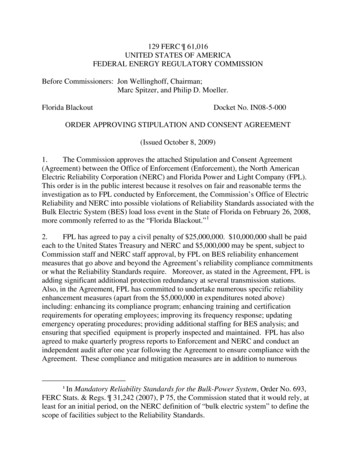
Transcription
129 FERC ¶ 61,016UNITED STATES OF AMERICAFEDERAL ENERGY REGULATORY COMMISSIONBefore Commissioners: Jon Wellinghoff, Chairman;Marc Spitzer, and Philip D. Moeller.Florida BlackoutDocket No. IN08-5-000ORDER APPROVING STIPULATION AND CONSENT AGREEMENT(Issued October 8, 2009)1.The Commission approves the attached Stipulation and Consent Agreement(Agreement) between the Office of Enforcement (Enforcement), the North AmericanElectric Reliability Corporation (NERC) and Florida Power and Light Company (FPL).This order is in the public interest because it resolves on fair and reasonable terms theinvestigation as to FPL conducted by Enforcement, the Commission’s Office of ElectricReliability and NERC into possible violations of Reliability Standards associated with theBulk Electric System (BES) load loss event in the State of Florida on February 26, 2008,more commonly referred to as the “Florida Blackout.” 12.FPL has agreed to pay a civil penalty of 25,000,000. 10,000,000 shall be paideach to the United States Treasury and NERC and 5,000,000 may be spent, subject toCommission staff and NERC staff approval, by FPL on BES reliability enhancementmeasures that go above and beyond the Agreement’s reliability compliance commitmentsor what the Reliability Standards require. Moreover, as stated in the Agreement, FPL isadding significant additional protection redundancy at several transmission stations.Also, in the Agreement, FPL has committed to undertake numerous specific reliabilityenhancement measures (apart from the 5,000,000 in expenditures noted above)including: enhancing its compliance program; enhancing training and certificationrequirements for operating employees; improving its frequency response; updatingemergency operating procedures; providing additional staffing for BES analysis; andensuring that specified equipment is properly inspected and maintained. FPL has alsoagreed to make quarterly progress reports to Enforcement and NERC and conduct anindependent audit after one year following the Agreement to ensure compliance with theAgreement. These compliance and mitigation measures are in addition to numerous1In Mandatory Reliability Standards for the Bulk-Power System, Order No. 693,FERC Stats. & Regs. ¶ 31,242 (2007), P 75, the Commission stated that it would rely, atleast for an initial period, on the NERC definition of “bulk electric system” to define thescope of facilities subject to the Reliability Standards.
Docket No. IN08-5-000-2-actions taken by FPL on its own initiative after the event and during the course of staff’sinvestigation.Background3.FPL is a public utility with transmission, distribution, and generation operationsserving approximately 4.5 million customer accounts in Florida. Among other things,FPL is registered as Balancing Authority, Planning Authority, Transmission Owner,Transmission Operator, and Transmission Service Provider by NERC and is responsiblefor compliance with the Reliability Standards associated with those functions.4.Florida Reliability Coordinating Council (FRCC) is a not-for-profit companyincorporated in Florida. Along with serving as a “Regional Entity” responsible forproposing and enforcing Reliability Standards within its region, FRCC also performsvarious member services including functioning as the Reliability Coordinator (RC) underthe Reliability Standards. As an RC, FRCC has the responsibility and authority for thereliable operation of the BES within FRCC and compliance with associated ReliabilityStandards. FRCC performs this function through a contract with FPL, by which FPLexecutes the RC function through FPL control room personnel. FPL also holds asubstantial share of the membership of FRCC with respect to the member servicesfunctions.5.On February 26, 2008, portions of the lower two-thirds of the State of Floridaexperienced a loss of load event more commonly referred to as the Florida Blackout. Theevent led to the loss of 22 transmission lines, 4,300 MW of generation, and 3,650 MW ofcustomer service or load. In response to the event, the Commission publicly announced aformal non-public investigation into the cause and events surrounding the blackout. 26.The event originated at the Flagami Substation on the FPL system when a fieldengineer was diagnosing a piece of BES transmission equipment that had previouslymalfunctioned. Specifically, on February 23, 2008 and February 24, 2008, when the FPLLoad Dispatcher on duty in the FPL control center in Miami attempted to initiateseparating one of the shunt reactors (a voltage control device) at Flagami from the 138kVbus by opening the associated circuit switcher, a lock-out relay for the reactor tripped theassociated breaker. The relays were reset and the circuit switcher was tagged“emergency use only.”7.On February 26, 2008, a FPL Protection and Control (P&C) Engineer was sent totest the circuit switcher at Flagami. Once there, he disabled the primary protection andthe breaker failure protection (considered the secondary level of protection). The P&CEngineer did not notify the Load Dispatcher on duty in the FPL control center that he had2Order of Non-Public, Formal Investigation, 122 FERC ¶ 61,244 (2008).
Docket No. IN08-5-000-3-disabled the second level of protection and neither the System Operator on duty in theFPL Control Center nor the RC were aware that any protection had been disabled.8.At the request of the P&C Engineer, the Load Dispatcher then opened the circuitswitcher, and due to the failure of the circuit switcher’s bottle interrupter, a fault on thesystem occurred. The fault caused a 17-19 second arc which spread to the adjacent shuntreactor’s circuit switcher, which in turn caused a three phase fault on the 138 kV system.Because the primary and secondary levels of protection were disabled, the fault wascleared remotely in approximately 1.7 seconds. This resulted in significant frequencyswings, voltage excursions and tripping of transmission and generation around portionsof the lower two-thirds of Florida.Applicable Reliability Standards9.On March 16, 2007, the Commission approved the first Reliability Standards, 3submitted by NERC, pursuant to section 215 of the Federal Power Act. 4 Thosecategories of Reliability Standards applicable to the Agreement are described below:10.The Balancing (BAL) group of Reliability Standards address balancing resourcesand demand to maintain interconnection frequency within prescribed limits. 511.The Communications (COM) group of Reliability Standards require adequateinternal and external telecommunications facilities and that these communicationfacilities be staffed and available to address real-time emergencies and that operatingpersonnel carry out effective communications. 612.The Emergency Preparedness and Operations (EOP) group of ReliabilityStandards address preparation for emergencies, necessary actions during emergencies andsystem restoration and reporting following disturbances. 73Mandatory Reliability Standards for the Bulk-Power System, Order No. 693,FERC Stats. & Regs. ¶ 31,242 (2007).416 U.S.C. § 824o (2006).5Mandatory Reliability Standards for the Bulk-Power System, Order No. 693,FERC Stats. & Regs. ¶ 31,242, P 305 (2007).6Id. P 472.7Id. P 541.
Docket No. IN08-5-000-4-13.The Personnel Performance, Training and Qualifications (PER) group ofReliability Standards are intended to ensure the retention of suitably trained and qualifiedpersonnel in positions that can impact the reliable operation of the BES. 814.Protection and Control (PRC) group of Reliability Standards cover a wide range oftopics related to the protection and control of power systems. 915.The Transmission Operations (TOP) group of Reliability Standards ensure that thetransmission system is operated within operating limits and specifically cover theresponsibilities and decision-making authority for reliable operations, requirements foroperations planning, planned outage coordination, real-time operations, provision ofoperating data, monitoring of system conditions, reporting of operating limit violationsand actions to mitigate such violations. 1016.The Transmission Planning (TPL) group of Reliability Standards ensure that thetransmission system is planned and designed to meet an appropriate and specific set ofreliability criteria. 11Stipulation and Consent Agreement17.Enforcement and NERC allege that FPL violated Reliability Standards in theBAL, COM, EOP, PER, PRC, TOP, and TPL areas. FPL does not admit that its actionsconstituted violations of the Reliability Standards.18.The Agreement provides for a substantial civil penalty in the amount of 25,000,000 that reflects the seriousness and nature of the event and yet takes account ofefforts to remedy the violations. This amount is to be paid in a manner that reflects thedual nature of this investigation which both the Commission and NERC conducted and inrecognition that some amount of expenditure above the requirements of the ReliabilityStandards on additional reliability measures is in the public interest. Accordingly, FPLshall pay 10,000,000 each to the United States Treasury and NERC and 5,000,000 maybe spent, subject to Commission staff and NERC staff approval, by FPL on Bulk ElectricSystem (BES) reliability enhancement measures that go above and beyond the reliabilitycompliance commitments that are also a significant feature of the Agreement or what theReliability Standards require. If FPL has not spent or committed to spend for approvedprojects all of the 5,000,000 amount within three years of the Effective Date of the8Id. P 1324.9Id. P 1418.10Id. P 1567.11Id. P 1683.
Docket No. IN08-5-000-5-Agreement, the amount or any remainder of the amount shall be paid and divided equallybetween the U.S. Treasury and NERC. Also, except as required by law, this amount maynot be deducted or otherwise treated favorably to FPL for tax purposes nor recovered inrates by FPL.19.The Agreement also provides for substantial, wide ranging, and specific reliabilityenhancement measures (apart from the 5,000,000 in expenditures noted above) that are asignificant element to the resolution of this matter. These include FPL committing to:enhance its overall electric reliability compliance program; enhance training andcertification requirements for operating employees; improve its system’s frequencyresponse performance; update its emergency operating procedures; provide additionalstaffing for BES analysis; and ensure that specified equipment is properly inspected andmaintained. FPL has also agreed to make quarterly progress reports to Enforcement andNERC and conduct an independent audit after one year following the Agreement toensure compliance with the Agreement. These compliance and mitigation measures arein addition to numerous actions taken by FPL on its own initiative after the event andduring the course of staff’s investigation.20.In assessing the appropriate remedy, staff considered the serious nature of theevent and its impact on the BES. As the Agreement stipulates, this was a serious outage.On the other hand, staff also considered that FPL’s actions were neither intentional norfraudulent and that FPL demonstrated exemplary cooperation throughout theinvestigation. Also, FPL implemented voluntarily many reliability enhancementmeasures immediately following the event and throughout the investigation.Determination of the Appropriate Sanctions and Remedies21.We conclude that the penalty set forth in the Agreement is a fair and equitableresolution of this matter and is in the public interest, as it reflects the nature andseriousness of FPL’s alleged conduct and the event as well as the efforts taken by FPL toremedy the alleged violations, recognizing the company specific considerations as statedabove and in the attached Agreement. We also conclude that, under the specificcircumstances of this case, the payment provisions relating to the civil penalty reflect abalanced and sensible approach, including a portion to be paid to NERC and theallowance of a limited portion of the civil penalty to be spent by FPL to provideadditional reliability protections on the FPL portion of the BES. We also conclude thatthe reliability enhancement measures set forth in the Agreement are substantial, relatedirectly to the alleged violations, and will enhance BES reliability and are therefore alsofair and in the public interest.
Docket No. IN08-5-000-6-The Commission orders:The attached Stipulation and Consent Agreement is hereby approved withoutmodification.By the Commission. Commissioners Spitzer and Moeller concurring with separatestatements attached.Commissioner Kelly is not participating.(SEAL)Nathaniel J. Davis, Sr.,Deputy Secretary.
UNITED STATES OF AMERICAFEDERAL ENERGY REGULATORY COMMISSION2008 Florida BlackoutDocket No. IN08-5-000STIPULATION AND CONSENT AGREEMENTI.INTRODUCTION1.Staff of the Office of Enforcement (“Enforcement”) of the Federal EnergyRegulatory Commission (“Commission”), staff of the North American ElectricReliability Corporation (“NERC”) (collectively “staff”), and Florida Power and LightCompany (“FPL”) enter into this Stipulation and Consent Agreement (“Agreement”) toresolve a non-public investigation conducted by Enforcement, staff of the Office ofElectric Reliability of the Commission and NERC, pursuant to Part 1b of theCommission’s regulations, 18 C.F.R. Part 1b (2008), and NERC’s ComplianceMonitoring and Enforcement Program into alleged violations of the Reliability Standardsby FPL surrounding a loss of load event in Florida on February 26, 2008.II.STIPULATED FACTSEnforcement, NERC and FPL hereby stipulate to the following:2.On February 26, 2008, portions of the lower two-thirds of the Bulk ElectricSystem (“BES”) in peninsular Florida experienced a loss of service to electric customers.The event led to the loss of 22 transmission lines, 4,300 MW of generation, and 3,650MW of customer service or load. Approximately 596,000 FPL customer accounts and354,000 non-FPL customer accounts were out of service, representing approximately 8%of Florida electric customer accounts. In response to the event, the Commission publiclyopened a formal investigation into the cause and events surrounding the blackout. Orderof Non-Public, Formal Investigation, 122 FERC ¶ 61,244 (2008). NERC also opened aparallel Compliance Violation Investigation (NERC0002CVI).3.FPL is a public utility with transmission, distribution, and generation operationsserving approximately 4.5 million customer accounts in Florida.4.Based on industry benchmarking studies for the time period January 1, 2006through December 31, 2008, FPL’s distribution reliability, as measured by “SAIDI,”ranked in the top decile of performance.5.The FPL Control Center is located in western Miami. It has two levels, one whichincludes consoles for five “Load Dispatchers,” and another level which includes consoles
Docket No. IN08-5-000-2-for the “System Operator” and “Reliability Coordinator.” At the time of the event, LoadDispatchers were responsible for monitoring a specific region and ensuring that properswitching orders and clearances are issued and executed. They are the main contact withProtection and Control (“P&C”) Field Engineers. A Readiness Review conducted by theFlorida Reliability Coordinating Council (“FRCC”) and NERC in March 2004 included arecommendation relating to the Load Dispatchers and System Operator oversight. FPLtook actions to address these recommendations in June 2004. A Readiness Reviewconducted by FRCC and NERC during April 2007 determined that “FPL has takenappropriate actions to implement and satisfactorily resolve all of the recommendationsfrom the 2004 report” and did not identify Load Dispatcher certification as an area ofconcern. FPL did not require its Load Dispatchers to be NERC certified. The SystemOperator is responsible for supervising the Load Dispatchers and is charged withdirecting and implementing actions to ensure the stable and reliable operation of the FPLSystem. While the System Operator cannot effectively read the Load Dispatchers’monitoring screens from the System Operator desk and at the time of the event did notreceive the same alarms on his monitoring screens as the Load Dispatchers, the SystemOperator can access the same information that is available to the Load Dispatchers fromhis station. FPL requires its System Operators to be NERC certified. At times, includingFebruary 26, 2008, System Operators also fulfill the function of “ReliabilityCoordinator,” which is responsible for overseeing reliability in the entire FRCC region.6.FPL P&C Field Engineers are responsible for conducting maintenance andtroubleshooting on substation equipment. FPL P&C Field Engineers are highly skilled,experienced and trained and hold four year engineering degrees.7.The Flagami Substation is located in western Miami and is centrally located in thesouthern portion of the FPL transmission system. The 230 kV/138 kV station containstwo 138 kV shunt reactors, which are used to control voltage. Each shunt reactor isconnected to the 138kV bus by a circuit switcher, which consists of a Sulfur Hexafluoride(SF6) gas filled high speed bottle interrupter in series with a low speed air breakdisconnect switch. The circuit switchers were installed by FPL in 1987 and 1998.8.In 2001, FPL studied the effects of a fault at Flagami. Based on the results, itadded redundant primary bus differential relay protection at Flagami, but determined thatit was not necessary to add redundancy around the autotransformer at Flagami.9.On February 23, 2008 and February 24, 2008, when the Load Dispatcher on dutyattempted to initiate separating one of the shunt reactors at Flagami from the 138kV busby opening the associated circuit switcher, a lock-out relay for the reactor tripped theassociated breaker. The relays were reset and the circuit switcher was tagged“emergency use only.”
Docket No. IN08-5-000-3-10.On February 26, 2008, a P&C Field Engineer was sent to test the circuit switcherat Flagami. Once there, he disabled the primary protection and the breaker failureprotection (considered the secondary level of protection). At this point, the shunt reactorand its associated circuit switcher were operating live on the system with two levels ofprotection disabled for approximately 37 minutes.11.The P&C Engineer communicated the disabling of the breaker trip for the primaryprotection for the shunt reactors to the Load Dispatcher; the Load Dispatcher, wheninterviewed by staff, indicated that he did not understand that any protection had beendisabled. The Field Engineer did not inform the Load Dispatcher that he had disabled thesecondary level of protection. The Load Dispatcher did not request authorization for theremoval of any levels of protection from the System Operator and did not communicatethat one level of protection had been disabled to the System Operator. The SystemOperator’s monitoring equipment did not independently alert him to the disabling ofprotection by the P&C Field Engineer. The System Operator, unaware of the disabling ofprotection, did not conduct an assessment of the changed system configurations or takeaction within 30 minutes in response to the changed condition.12.The P&C Field Engineer performed a visual inspection of the bottle interrupter perFPL policy, which showed the presence of gas (which normally indicates properfunctioning), prior to working on the circuit switcher. At the request of the P&C FieldEngineer, the Load Dispatcher then opened the circuit switcher, and due to the failure ofthe circuit switcher’s bottle interrupter, a fault on the system occurred. Subsequentforensic evaluation showed that the metal contacts within the bottle interrupter werefused into in a closed condition due to a connecting rod failure. Also the semaphoreindicating low gas in the bottle interrupter had failed, giving a false indication of thepresence of gas (and thereby giving a false indication that it was functioning properly)during the P&C Engineer’s visual inspection.13.The fault caused a 17-19 second arc which spread to the adjacent shunt reactor’scircuit switcher causing a three phase fault on the 138 kV system. Because the primaryand secondary levels of protection were disabled, the fault was cleared remotely inapproximately 1.7 seconds. This resulted in significant frequency swings, voltageexcursions and tripping of transmission and generation around portions of the lower twothirds of Florida.14.Immediately after the fault, the System Operator/Reliability Coordinator assignedthe Reliability Coordinator responsibilities to a NERC-certified System Operator presentin the Control Center, but not involved in operations that day. The System Operator thenfocused on restoring the FPL system. At the time of the event, there were four operatorsNERC-certified at the Reliability Coordinator level in the Control Center.
Docket No. IN08-5-000-4-15.The System Operator then questioned the Load Dispatcher about the problem atFlagami. The Load Dispatcher reported that there had been a reactor fire at Flagami.After noting that Flagami was de-energized, the System Operator ordered all breakers atFlagami open.16.Of affected firm customers, 56% were restored to service within one hour, 84%were restored within two hours, and all non-interruptible customers were restored withinthree hours.17.While not the most significant event the BES has experienced, this was a seriousoutage.18.FPL’s action were neither intentional nor fraudulent.19.FPL demonstrated exemplary cooperation throughout the investigation.20.FPL implemented reliability enhancement measures immediately after the eventand throughout the investigation.21.As part of FPL’s ongoing reliability improvements to the system, FPL: (a) isimplementing protection redundancy for new transmission substations above 100 kV within-service dates of 2010 and beyond that is intended to ensure single-points-of-failure onprotection systems would not result in N-1 transmission system contingencies fromevolving into more severe or extreme events; (b) is adding high speed redundantprotection on the autotransformers at Flagami Substation; (c) is implementing protectionredundancy for the autotransformers at eight substations that have similar busarrangements as Flagami (Davis, Ft. Myers, Lauderdale Inner, Lauderdale Outer,Midway, Sanford Plant, Brevard and Ringling)(with two substations completed in eachyear commencing in 2009); and (d) in the interim period prior to completed in-servicedates, is implementing automatic remote monitoring of the protection circuit fuses anddeveloping a procedure for immediate action in the case of an alarm.III.RESOLUTION22.Enforcement and NERC alleged that FPL violated Reliability Standards in theBAL, COM, EOP, PER, PRC, TOP, and TPL areas. FPL does not admit that its actionsconstitute violations of the Reliability Standards or that it committed any violations of theReliability Standards. Nonetheless, in view of the costs and risks of litigation, and in theinterest of resolving all matters in dispute between Enforcement, NERC, and itselfregarding the acts in question, FPL agrees to undertake the obligations set forth in thisAgreement.
Docket No. IN08-5-000-5-23.This agreement does not constitute an admission of liability or wrongdoing byFPL to any third party and FPL does not consent to the use of this Agreement by anyother party in any other proceeding.24.For purposes of settling any and all civil and administrative disputes arising fromEnforcement’s and NERC’s investigation of FPL, and in lieu of any other remedy that theCommission or NERC might assess, determine, initiate, or pursue, concerning any of thematters referred to above, FPL agrees that after the Commission issues an orderapproving this Agreement without modification or condition, it shall take the followingactions:A. Civil Penalty25.FPL shall pay a civil penalty in the amount of 25,000,000. 10,000,000 shall bepaid each to the United States Treasury and NERC, within 10 days of the Effective Date. 5,000,000 shall be remitted and FPL may spend it to further enhance the reliability ofthe BES upon staff approval (which will not be unreasonably withheld) on additionalBES reliability enhancement measures not otherwise required under this Agreement or bythe reliability standards as in effect on the date of this Agreement. If FPL has not spentor committed to spend for approved projects all of such amount within three years of theEffective Date, the amount or any remainder of the amount shall be paid and split equallybetween the U.S. Treasury and NERC. Except as required by law, this amount shall notbe deducted or otherwise treated favorably to FPL for tax purposes nor recovered in ratesby FPL.B. Reliability Enhancement Measures26.FPL will adopt the following reliability enhancement measures:1. Enhancements to FPL Compliance Program: Within 6 months of theEffective Date, FPL will undertake incremental enhancements to itsexisting Reliability Standards compliance program with respect to all FPLowned or operated Bulk Electric System operations. This shall includespecified roles for senior management involvement, independent reportingof compliance management to senior executives outside of the businessunits that plan, operate and maintain BES equipment, internal auditing,accountability for reliability in compensation packages, a compliancehotline, a written reliability compliance manual, and improvements todocument databases, processes, and training. In addition, FPL will performpractice audits of all FPL Business Units, including a review of procedures,process flowcharts, and compliance documentation. FPL will also assessNERC compliance education and training for all employees responsible forcompliance with the Reliability Standards and implement improvements in
Docket No. IN08-5-000-6-these programs. To execute these enhancements, perform additionaltraining, document control and spot audits to enhance a sustainable cultureof compliance, FPL will provide additional employee support for itscompliance program. In its quarterly progress reports to the Commission asdescribed below, FPL shall document compliance improvement actionstaken to date. Some of the incremental enhancements set forth herein havebeen undertaken prior to the effectiveness of the Agreement.2. Training and Certification: FPL will enhance training to operatingemployees staffing the control room on the functionalities and limitationsof the protection schemes, emergency operations procedures and therequirement to utilize three part communication protocols of Direct-RepeatAcknowledge. This training shall address the reliability risks to the BESwhen a part or all of a protection scheme is removed for maintenance orother purposes. FPL will also provide detailed technical training for fieldrelay testing engineers regarding Protection and Control complianceactivities, which will include a phased-in certification program. Thistraining shall address seeking express permission from System Operatorsbefore switching or before work can be performed on energized BESfacilities and the protection systems. Some of the incrementalenhancements set forth herein have been undertaken prior to theeffectiveness of the Agreement. In addition, FPL’s initiative to NERCcertify all load dispatchers is currently in progress and will be completedper the schedule agreed upon in a separate Remedial Action DirectiveSettlement with NERC.3. Frequency Response: FPL will implement measures to maintain its averagefrequency response for any calendar year (measured as being equal to itsaverage frequency response in response to all events, as defined by theResource Subcommittee of the NERC Operating Committee, that occurduring such calendar year) to be as close as reasonably practicable to itsfrequency bias setting for such calendar year (it being understood that theCompany’s frequency bias setting is equal to 1% of its maximum peakload). For the purpose of maintaining such frequency response, bothgeneration and load demand response measures will be acceptable.Frequency response measures to meet the above-referenced performancecriteria shall include some combination of the following: Modify generating units’ droop characteristics. Apply controllable demand response technology (it beingunderstood that such technology that responds in a mannerthat is substantially similar to the response shown on
Docket No. IN08-5-000-7example Attachments A-1 and A-2 would be amongtechnology that is considered acceptable for thesepurposes).FPL’s obligation to maintain such frequency response shallcommence in no event later than one year from the Effective Date(as this obligation likely will commence in the midst of a calendaryear, the parties agree that only events that occur after thecommencement of such obligation through the remainder of suchcalendar year shall be considered in determining whether FPL hascomplied with such obligations for such initial calendar year).4. Update Emergency Operating Procedures: FPL will review and modify, asis reasonably necessary, plans to mitigate operating physical emergenciesincluding fires within stations or on BES transmission facilities. Theserevised procedures will be reviewed by NERC and FERC Staff. Suchprocedures shall specify a situational assessment to identify and, if possible,isolate the specific portion of the switchyard that is on fire. In the quarterlyprogress reports to the Commission, FPL shall document actions to betaken to conduct reasonably adequate emergency training of these revisedprocedures to operators of the BES.5. Additional Operations Engineers for BES Analysis: FPL will staff twoadditional operations engineers to perform additional BES analysisincluding increased modeling scenarios for both planning and real-timescenarios as well as day-to-day contingency analysis.6. Equipment Maintenance: To the extent not h
FPL is a public utility with transmission, distribution, and generation operations serving approximately 4.5 million customer accounts in Florida. Among other things, FPL is registered as Balancing Authority, Planning Authority, Transmission Owner, Transmission Operator, and Transmission Service Provider by NERC and is responsible




